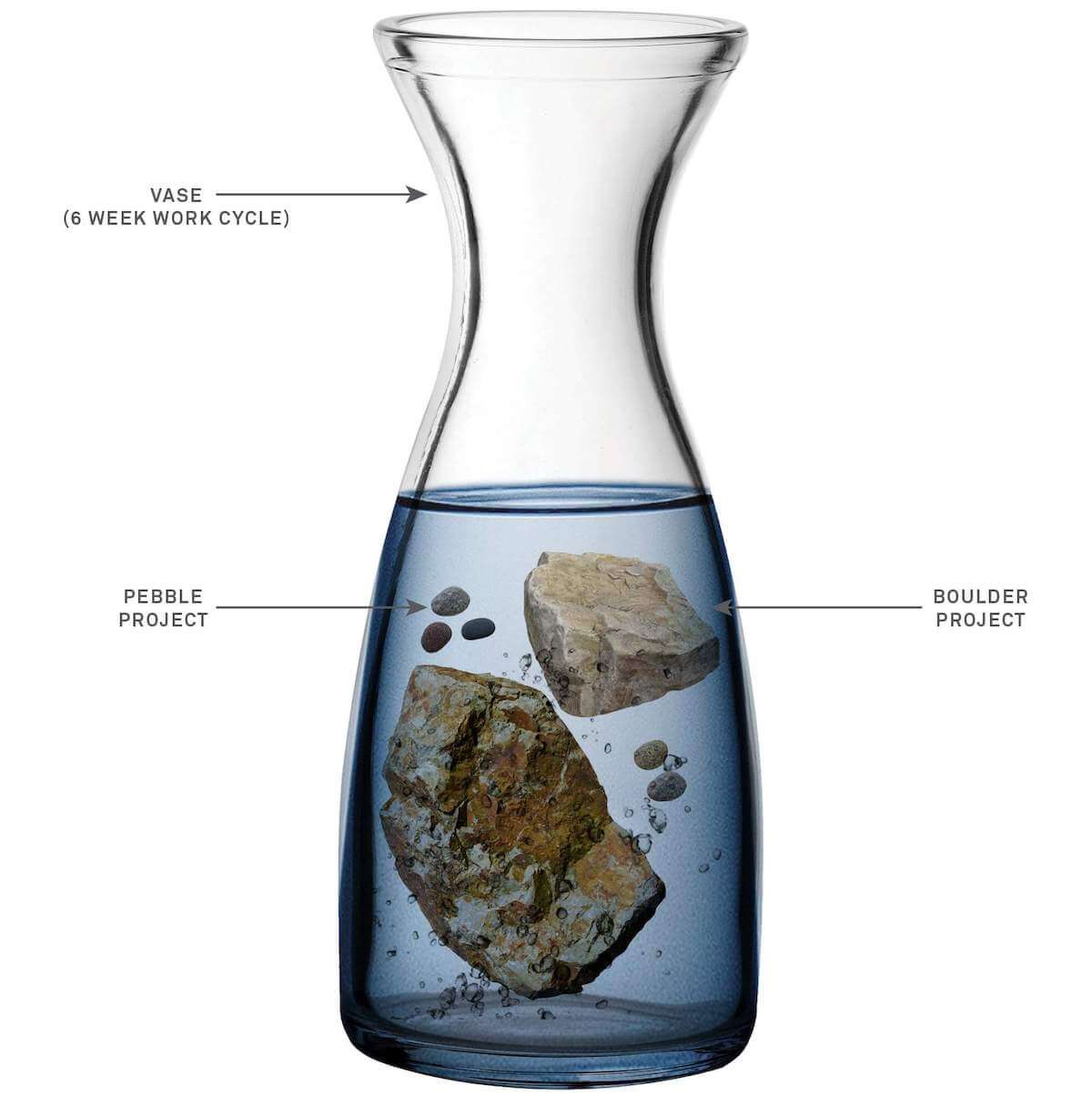
5 strategies to help you avoid burnout at work
Main illustration: Rachel Tunstall
When you’re working in a fast-paced industry, it’s all too easy to reach burnout – no matter what role you’re in.
And when you work on multiple concurrent projects and across lots of teams, the risk of burnout isn’t just high, it can feel inevitable. Many individual contributors (such as researchers, visual designers, content strategists, data scientists) who work horizontally across teams can be viewed as an infinite resource. We come in, we work our magic (usually in a short space of time) and then leave again to do the same on another team.
What is burnout?
There’s a lot of conversation around what burnout actually is, and discrepancies between definitions can make it harder to spot the signs. According to WebMD:
Burnout is “a form of exhaustion caused by constantly feeling swamped. It’s a result of excessive and prolonged emotional, physical, and mental stress.”
It’s not always the case, but burnout is often associated with work. A person’s risk of burnout at work depends on a range of factors, and personal habits and practices are just a small part of the puzzle. Nevertheless, strategies for effective workload management can help, even if there are external influences that are outside your control.
Breaking the vicious cycle of impossible deadlines
Sometimes when we’re working in a “service” function, we do ourselves a disservice. We essentially “drop into” a project with an unrealistic deadline, get the work done regardless, and then leave. And we wonder why stakeholders expect the work to be done faster and faster, with tighter deadlines? It can quickly become a vicious cycle. But it doesn’t have to be this way.
There are lots of different strategies to help you prioritize self-care and avoid burnout at work – these are even more important in the world of remote or hybrid work, where the divide between work and life blurs.
“Communicating your process to other teams and colleagues, and clearly setting realistic, sustainable expectations, is key to protecting yourself from becoming over-burdened”
Communicating your process to other teams and colleagues, and clearly setting realistic, sustainable expectations, is key to protecting yourself from becoming over-burdened. Establishing an understanding of not only how much work takes place, but how long it takes and how your projects are prioritized can drastically change your work life as an individual contributor. Here are some useful tips to monitor your workload and guard against burnout at work.
Make your roadmap visible to everyone
The first step to communicating your process is making sure your project roadmap is transparent and visible to everyone. This can be straightforward, for instance, if you have your roadmap in Coda or a spreadsheet, ensure that it’s accessible for everyone in the company. Then you can link to the overall team roadmap on your internal team page or pin it to your team’s Slack channel, depending on how your team works.
“If a person isn’t aware of what else you’re working on, they could assume you just don’t want to work on their request”
If you’re an individual contributor who works horizontally across teams, it’s imperative that your colleagues understand that you collaborate on multiple projects, not just theirs. This will help immensely when you have to turn down a project, extend a deadline, or downsize your workload. If a person isn’t aware of what else you’re working on, they could assume you just don’t want to work on their request. This can lead to tension, creating a stressful environment and increasing the risk of burnout at work.
Offer realistic timelines
Understandably, most people don’t have an in-depth knowledge of the nuances and intricacies of other disciplines. As a result, they can greatly underestimate the time commitments required by various projects. To resolve this, consider sharing estimated timelines for different types of work that you do. For instance, you might include a timeline in every research plan to raise awareness of what goes into each research project. By highlighting all the critical building blocks of a project that might be invisible to colleagues, you create more realistic expectations around your bandwidth. That in turn leads to more reasonable expectations of your ability to commit in future.
Practice the art of the “positive no”
Protecting your time means occasionally saying no. So how do you respond to a request that you’re unlikely to be able to prioritize? Without a strategy, you’re more likely to get pulled into projects you can’t realistically accommodate. Enter the “positive no.”
This term was made popular by author William Ury in his book The Power of a Positive No. The concept is pretty simple – a positive no consists of a “Yes! No. Yes? statement.” In Ury’s words: “The first Yes! expresses your interest; the No asserts your power; and the second Yes? furthers your relationship.”
“When you have a team requesting more of your time or resources than what is possible, it’s important you don’t dismiss those requests by saying ‘No, I can’t work on that.’ straight away”
When you have a team requesting more of your time or resources than what is possible, it’s important you don’t dismiss those requests by stating “No, I can’t work on that.” straight away. This isn’t going to help with building meaningful relationships with other teams. Let’s face it, these requests are inevitable – not every project can be precisely scoped out far in advance, after all. Instead, respond with something like “That sounds like a great idea. Can we chat more about this to see if I can fit it into this cycle?”
Another technique that works well has been used in improv. comedy for years whereby you respond to requests with “Yes, and…” instead of “No.” This directs you away from a negative mindset when faced with a difficult request, while allowing you to shape the level of your commitment.
Introducing these techniques should make these tough conversations around bandwidth easier to handle. Instead of shutting people down, they open up the conversation to gauge what they need, while also communicating what your constraints are.
Treat any ask as a request before committing to it
You’re probably going to find that even when you proactively share your roadmap and practice the art of the positive “No”, sudden ad hoc projects will still arise. When faced with more demands than you can handle, a valuable approach is to differentiate between broad requests and actual projects that need to be worked on.
“This can be a great forcing function for colleagues to think deeply about the ideas they have, so that it’s no longer a fuzzy concept but a well-considered idea”
Ask colleagues who are making requests on your time to outline why it is a priority. This crucial step will dissuade other teams from approaching you before their needs are fully scoped. On the Content team, for example, if we received a request to produce a customer guide, we might ask that teams scope out requests by asking questions like:
- Why is now a good time to create this guide?
- How does this guide align with wider company goals?
- How will we measure the success of this guide?
This can be a great forcing function for colleagues to think deeply about the ideas they have, so that it’s no longer a fuzzy concept but a well-considered idea leading to actual results. Depending on your discipline or the size of your team, this process can evolve into a fully fledged request intake system, with set criteria determining the prioritization of projects.
Consider the boulders and pebbles
A common contributor to workplace burnout is the feeling of having an overwhelming amount of work to do, without a clear sense of where to even begin. It can be hard to decide what will have the most impact, and you can quickly begin to feel overburdened.
This is why prioritizing your tasks is so important, but it can be surprisingly tricky to master. The “boulder/pebble” metaphor can be hugely helpful when learning how to manage your workload effectively.
“The vase may look full with the two big boulder projects in it, but if you look closely, there’s still room for smaller, lower-priority projects. These are ‘pebble projects’”
Imagine a big glass vase. The vase represents a working cycle (a month, a quarter, what have you). Inside the vase are some big boulders. These represent your “priority projects” – projects that tie into a company goal or correlate to the success of a new feature or product.

Every cycle will have one or two boulder projects. The vase may look full with the two big boulder projects in it, but if you look closely, there’s still room for smaller, lower-priority projects. These are “pebble projects” – for the Content team, these could involve activities like pulling together performance metrics for a past content campaign, or updating an old blog post with new, more relevant content.
They could also be personal goals like presenting at a company meeting or attending professional development training. The boulders should dominate your work time, the pebbles should be accommodated around the boulders where possible.
Once you apply this metaphor to your work, you’ll be surprised how easy it becomes to conceptualize the demands on your time as either being boulders or pebbles. You can also share this metaphor with other teams to help them understand that you will have to fit their requests around your main priorities.
“Letting your colleagues know a request will be closer to a boulder than a pebble adds important context”
It is a useful way of communicating the level of effort required for different projects – something may appear effortless to another team, but actually involve a huge amount of work. Letting your colleagues know a request will be closer to a boulder than a pebble adds important context. The metaphor also helps you gauge your own workload – have you been spending enough time on the boulders or have you been diverted by too many pebbles?
Avoiding burnout at work is more important than ever, particularly at this stressful time. It’s vital that we learn how to protect ourselves from over-committing on projects while still making the biggest impact we possibly can. Hopefully, these tips and strategies help you do just that.
We want to help you to have the best experience of your career – check out our open roles.







